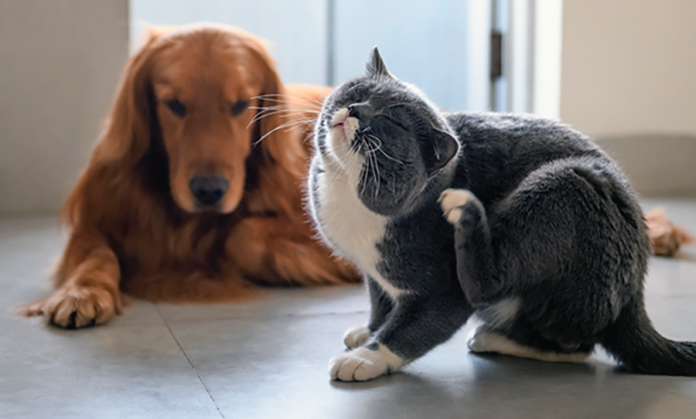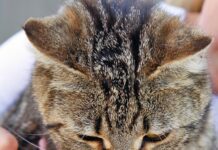Everyone hates to find a flea crawling on their cat. The typical response is immediate: a bath followed by an effective topical, such as a monthly spot-on treatment. The catch is that you should consider the unseen fleas, too. The one flea you saw is backed up by hundreds more.
If you treat your animals with an effective antiflea product, but neglect to prevent recurring infestation in the environment, you won’t resolve the problem.
“Skunks, raccoons, squirrels, and other wildlife can seed your backyard with fleas. If you have a cat who goes outside, or a dog, they can bring one or two fleas inside, and suddenly you’ll have thousands of fleas,” says William H. Miller Jr. VMD DACVD, Professor Emeritus of Medicine, Section of Dermatology at the Cornell University College of Veterinary Medicine.
What You Should Do
- Use a topical flea-control product if any animals go outside the home
- Don’t stretch time between applications; those guidelines are based on clinical studies
- If you see one flea, figure there are hundreds more
- Weigh the efficiency of chemical versus natural choices when battling an infestation
Tackle Your Home
Keeping the home flea-free is even more important than keeping the cat clean. Fleas—as eggs, larvae, and pupae—spend up to 90% of their time off the pet, usually on the carpet or furniture. The fleas you see on your pets are just the tip of the iceberg.
Once your cat is treated, work on your home. Immediately. Eggs can hatch within a day or two. Thoroughly vacuum, under furniture and beds, chair cushions, and every inch of the upholstery. Pay attention to cracks, crevices, and corners where flea eggs may have been deposited.
After vacuuming, seal the vacuum bag and remove it from the house. If you use a bagless vaccum, start with an empty container and immediately remove it when you finish, carefully dumping it (outside!) into a sealable plastic garbage bag—and seal it.
Doing a steam cleaning of any carpets or rugs helps destroy flea eggs. Carefully mop non-carpeted floors to pick up any eggs or larvae in cracks or along baseboards. Wash all your pet bedding, drapery, and anything else you can.
Natural Flea Predators
Insect parasite nematodes—a parasitic worm—can help control fleas outdoors. Studies show that these nematodes are most effective against fleas in moist, sandy soils. Flea control with nematodes on grass is not highly effective. They work best on bare soil surfaces that have adequate moisture.
Mary McMullen of the University of Florida Extension explains that these nematodes are microscopic, unsegmented round worms that live in the soil and infect many soil-dwelling pests. The third larval stage carries Xenorhabdus species bacteria, which kills the pest (in this case the flea). The juvenile nematode enters the pest’s body either through body openings or by piercing the pest’s body wall. Once the bacteria are introduced into the pest, the pest usually dies within 24 to 48 hours. The nematode then reproduces, and its offspring feed off the carcass until they reach the third larval stage and exit, ready to infect another pest. It may take six to eight weeks before you notice a true decrease in the flea population, so while nematodes may work at controlling fleas if used correctly, there are faster options out there.
Pesticides
With severe or long-standing infestations, you may need to go a step further and consider a pesticide treatment. The two steps to this process are: 1) killing adult fleas and 2) preventing the development of larvae and eggs.
Insect growth regulators (IGRs), such as methoprene and hydroprene, can break the flea lifecycle and are not known to harm people or pets. IGRs disrupt the growth and reproduction cycle of many insects, including fleas.
When a flea larva ingests or contacts with methoprene, it still grows normally, and spins a cocoon, but does not pupate. Therefore, no adults emerge from the cocoon. Adult fleas are not affected by the growth regulator, but when they die, they will not be replaced by newly maturing adults. However, because adults are not affected, an insect growth regulator alone will not help you quickly control existing flea problems.
If you end up going the pesticide spray route, plan on having all your pets out of the house for at least a few hours. If the timing works, schedule them for a flea bath at the groomer’s during the spraying. Shut cupboards and plan to wash all pet food, water bowls and litterboxes thoroughly after the treatment. Toys should also be washed or replaced.
Severe infestations in your home that cannot be controlled should be handed over to a professional. While “flea bombs” you can buy at a hardware store work, they’re usually not appropriate for your home. They are better suited for a shed or garage where no one lives and there is no food stored.
Do not use D-limonene, a citrus peel extract, around cats. While it is toxic to adult fleas, many cats will have severe adverse reactions to it.
Outside Orders
Even if your outdoor cat or dog does not have direct contact with wildlife, if they go to the same areas that wildlife does in your yard, they can pick up fleas. Fleas and wildlife like crawl spaces, like under shrubbery or in outdoor sheds or even your garage.
Fleas prefer warm, moist areas that are protected from direct sunlight. You need to block those areas off from your pets and the local wildlife if you have a major flea problem.
Mow your lawn short, which is less attractive to wildlife and fleas. Rake up leaves and lawn debris.
You can discourage fleas from occupying your yard by using plants that repel them. Commonly recommended plants that are pet safe include rosemary, thyme, sweet basil, and marigolds. Note that these plants do not kill fleas; they are unpleasant to fleas, so hopefully the fleas choose to move away. Fleas also avoid catnip and most mint plants.
Your best bet in dealing with fleas is to be vigilant. Use cat-safe preventatives, and initiate treatment as soon as you see even one flea on your cat. Discuss the use of topical-spot treatments and other options with your veterinarian.
If you have any house animals that go outside, you’ll need to treat your inside-only cats to keep control of flea activity. Fleas are smart, and they can easily jump from canine carriers to feast on any resident felines.
Diatomaceous Earth
We won’t grade it as an F, because diatomaceous earth (DE), a silica-based dust, has the potential to destroy the exoskeletons of flea eggs and flea larvae, ultimately killing them, but its effectiveness is debatable.
If you choose to use it, apply it to carpets, along baseboards, and on cat-scratching posts. Leave it down for a few hours and then vacuum it up. You will need to repeat this weekly. If you decide to try this, only use food-grade DE products (some people use food-grade DE to improve skin and hair health, as a toothpaste, and as a treatment for constipation).
While not toxic if eaten, breathing the dust from food-grade DE can irritate the lungs. Block pets out of the areas you are treating until after you vacuum. DE can be tried outside as well. It can’t hurt.




